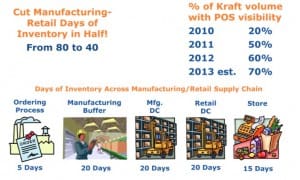 Whether we like it or not, every company on the planet with any significant supply chain operation has an inventory reconciliation problem. It doesn’t matter if you are a retailer, manufacturer or logistics service provider, or if you have the latest and greatest warehouse management system. The fact is, if humans have to physically touch or scan inventory in the put away, inventory check or pick process, then errors will occur. The only debate will be the size and scale of the problem.
Whether we like it or not, every company on the planet with any significant supply chain operation has an inventory reconciliation problem. It doesn’t matter if you are a retailer, manufacturer or logistics service provider, or if you have the latest and greatest warehouse management system. The fact is, if humans have to physically touch or scan inventory in the put away, inventory check or pick process, then errors will occur. The only debate will be the size and scale of the problem.
I talk to many organizations and they all deal with this problem. As you can imagine, there is a broad array of approaches taken and process maturity across companies. Some never check, some shutdown operations to do a full check, and others have a robust approach to cycle counting. In the best case scenario, you have a process that gets you into the 95% to 99% confidence level of inventory. Why not 100%? Just to reiterate, you may have the best warehouse staff on the planet, but if they are following manual repetitive tasks, errors will unfortunately occur.
Industry leading companies are now looking into autonomous UAS (Unmanned Aircraft System) technology or drones, coupled with advanced sensors capabilities, including passive-RFID, optical, and barcode, to significantly improve the operational effectiveness and efficiency of inventory checks in yards, lots, and inside of warehouses. Elevating the sensor platform into the air with the use of an autonomous UAS enables automatic, accurate, efficient, and safe inventory checks in hard to reach locations.
However, today this technology is very much in beta in a number of supply chain environments. The key message here is if you don’t have an initiative looking at drones, you are behind your competitors. There are many large corporations that are absolutely working on this, and there are others that have not even started. So if you fall in the latter category, you are going to have some problems ahead of you.
Everyone else’s margin is your opportunity. If you are not focusing on making your supply chain better-faster-cheaper, which pretty much every supply chain is doing today, then you have a problem on your hands. Take manual repetitive tasks and put it in the arms of an autonomous robot. Just do that, and you are going to have significant return on your hands, especially if you are operating at scale. So the bullet point here is if you’re not doing anything right now, if you’re not even talking about it right now, your competitors are. Period.
I don’t want to come across as flippant, but the ideal timeframe to start looking at this was six to twelve months ago. I don’t want to overemphasize the point, but this is highly relevant for any company that has a massive supply chain. The reality is that this technology is moving faster than Moore’s Law is in the semiconductor business. You just need to look at the amount of money being pumped into the drone business, the number of use-case applications, the number of companies that are looking at adopting it, the advances and cost performance of all the technology related to it. It is moving so much faster than any other technology that I am aware of. You really need to be looking at it right now.
In terms of a pilot, the way that companies have engaged us, they say, “Here’s what our problems are. Is this something that is a near-term opportunity for this type of technology?” Invariably that means us going out, taking a look at the facility, collaborating on the potential key-use cases, and then putting together a proof-of-concept to show the value. There’s no point in introducing a technology that brings more burden and more cost structure. This needs to radically change and shift the way companies are operating today. If it is not going to have that impact, you are wasting your time and you should move on to another use-case in your organization. There is undoubtedly an application in your organization that is going to have the biggest return, and we want to find that.
We have been thoughtful in our approach to focus on specific areas that we are good at, and it seems to be resonating with the people we talk to. We can rapidly understand if it is going to be worthwhile for a particular organization. For instance, if you are working with a 10,000 sq. ft. warehouse, you are wasting your time. If you have a 1,000,000 sq. ft. distribution center, we can generate significant value.
Why should we care?
It all boils down to the customer experience. I know how frustrated I get when I try to buy a product online and the retailer doesn’t know for sure if the item is in stock or it cannot deliver it to me in a timely fashion. And believe me, it has happened to me in well-known retailers. Consumers want retailers to set reasonable expectations and consistently meet them.
If a retailer has 100 distribution centers, each carrying $25M worth of inventory, with a 1% inventory error rate, you can imagine the scale of ambiguity and exposure that would persist around inventory items across its distribution network.
The #1 reason why organizations care is inventory accuracy, and the race to 100% confidence level exists across all omni-channel organizations.
What are the potential solutions to this problem?
I touched on a potential approach in a previous blog post regarding the Four Stages in Digital Disruption, which in the context of cycle counting would mean:
- Managed: How does my warehouse management system (WMS) prioritize and manage my process of dealing with inventory?
- Assisted: How does the use of barcode/RFID scanners, wearables and other technology enable warehouse operators do their job more consistently?
- Automated: What autonomous robots exist for the purpose of checking inventory at the frequency I prefer?
- Optimized: What technology exists to give me greater insight into inventory levels, position, movement, etc. with the real-time data received from autonomous robots?
Interestingly enough, organizations that are approaching me for help with #3 and #4 already have significant competence in #1 and #2. But because #1 and #2 still depend heavily on humans, they are still falling short on their inventory level confidence.
By passing the job of automatic cycle counting to an autonomous robot, organizations now have an enabler to get to the 100% confidence goal they are trying to achieve. For example, as reported by Reuters a few months ago, Walmart is 6-9 months from using drones to check warehouse inventory. According to the article, “drones can reduce the labor intensive process of checking stocks around the warehouse to one day, [which] currently takes a month to finish manually.”
—
Matt Yearling is CEO of PINC Solutions. He joined PINC as chief executive officer in March 2013 and is responsible for the overall strategic and operational management of the company. Matt’s past roles include vice president and general manager of Encryption Products at Symantec Corporation, senior vice president of Global CRM Product Development at Sage Inc., Chief Technology Officer for Embarcadero Systems Corp (a Ports America company). As vice president of Oracle On Demand, Matt played a pivotal role in making it Oracle’s fastest growing line-of-business.

















